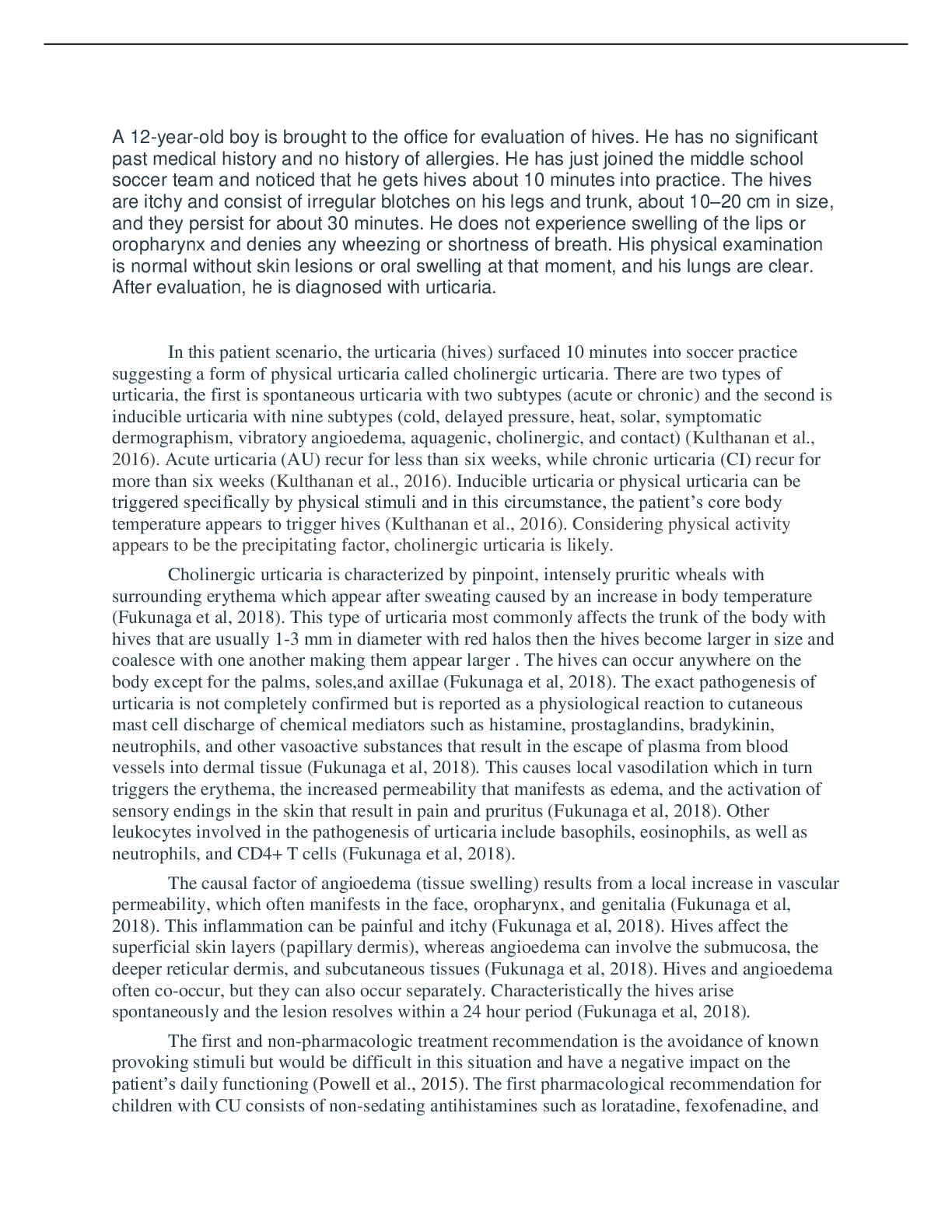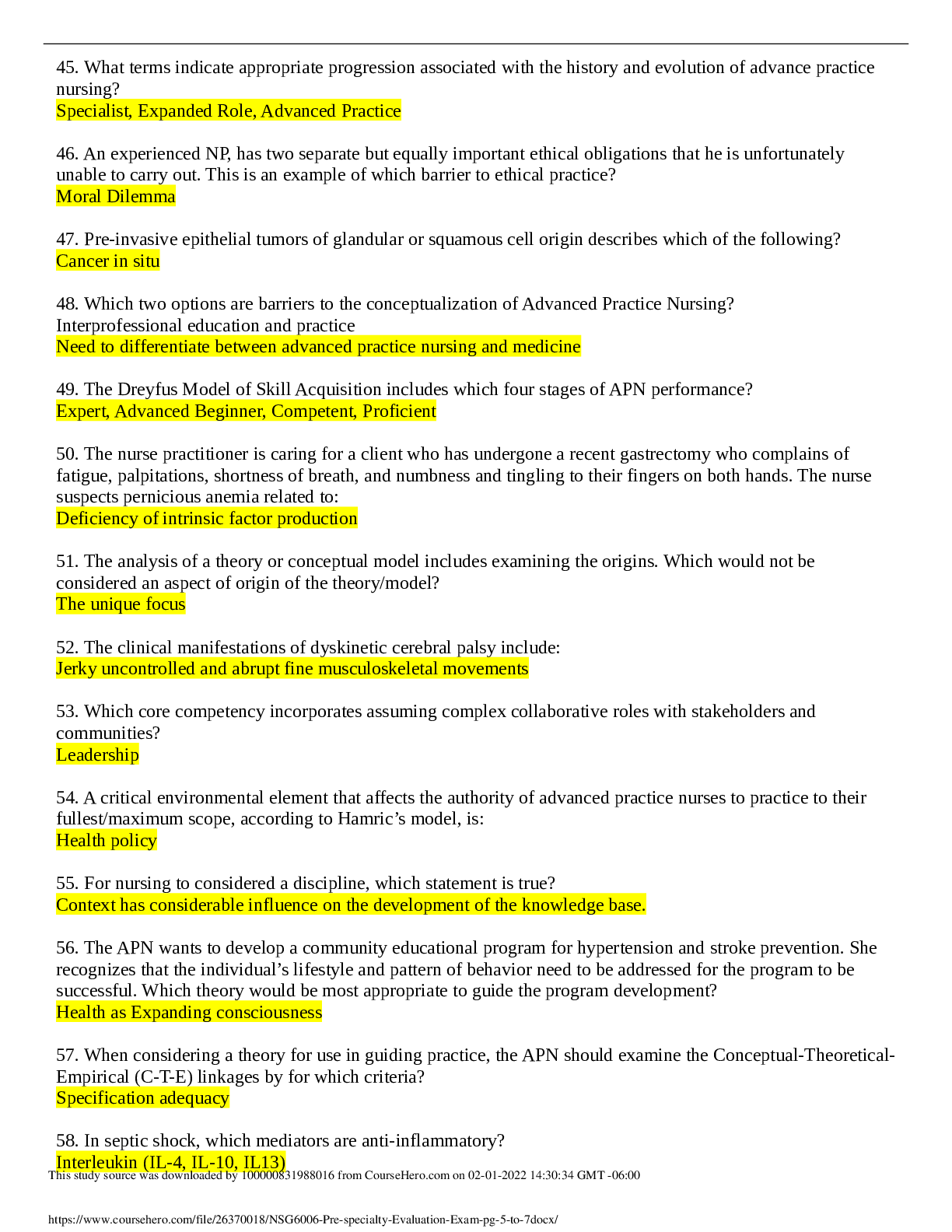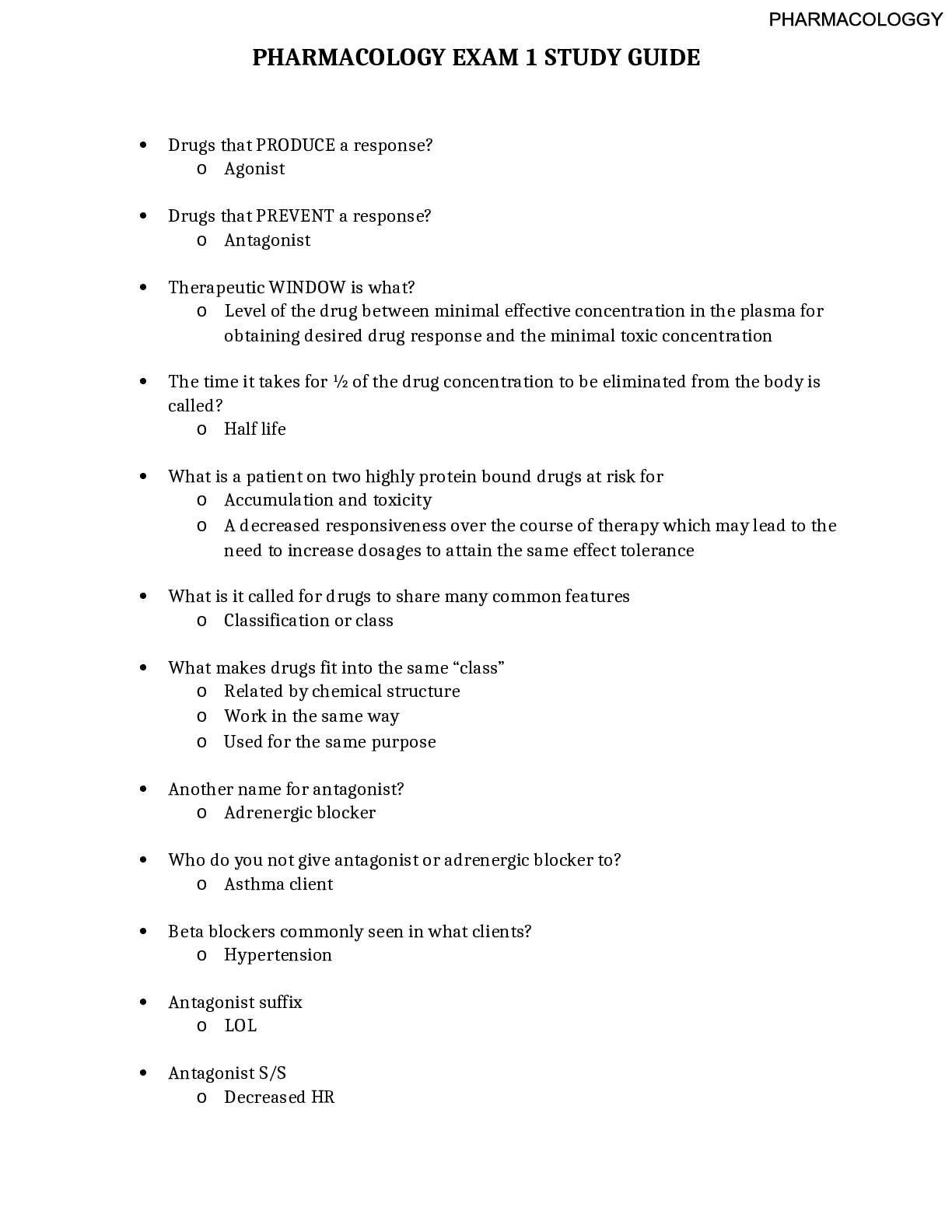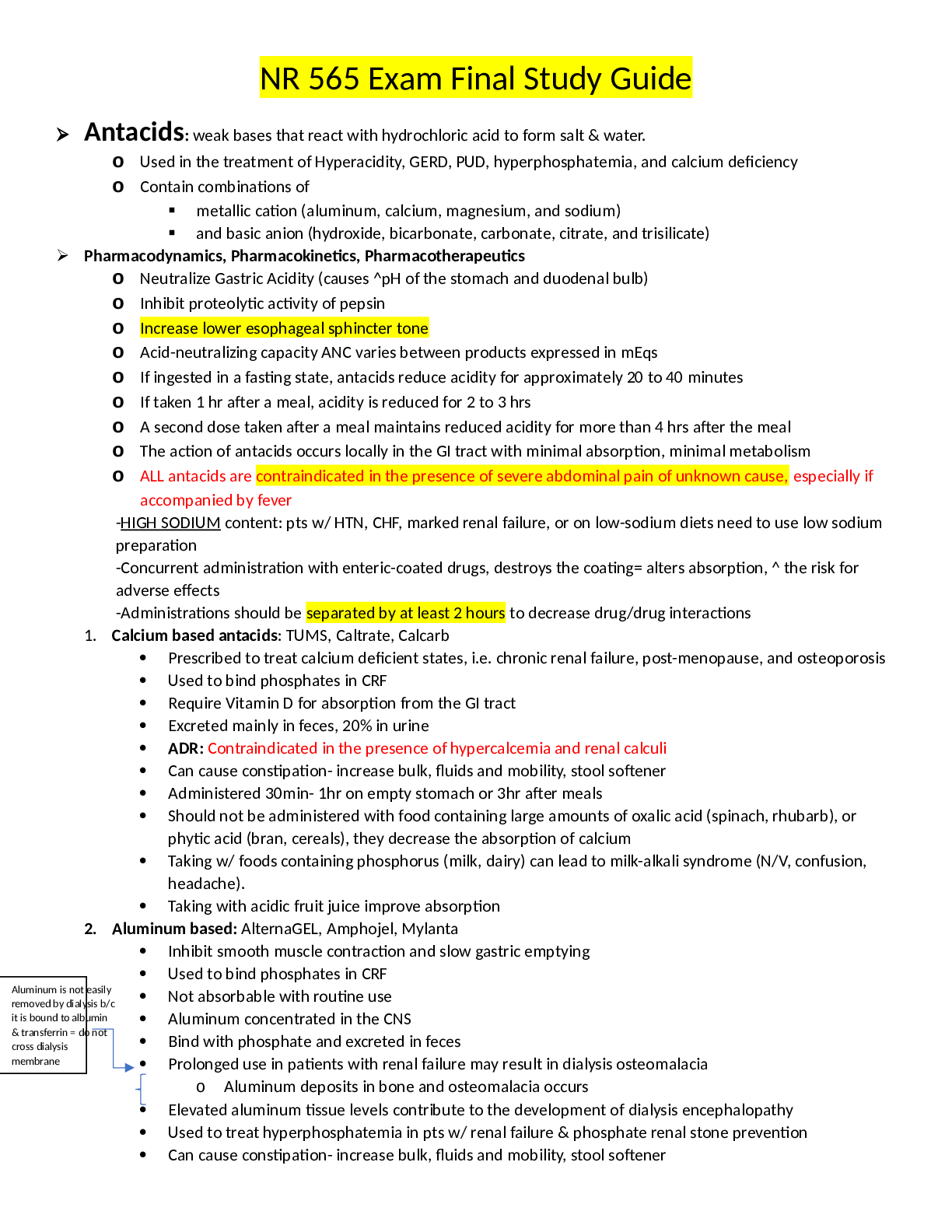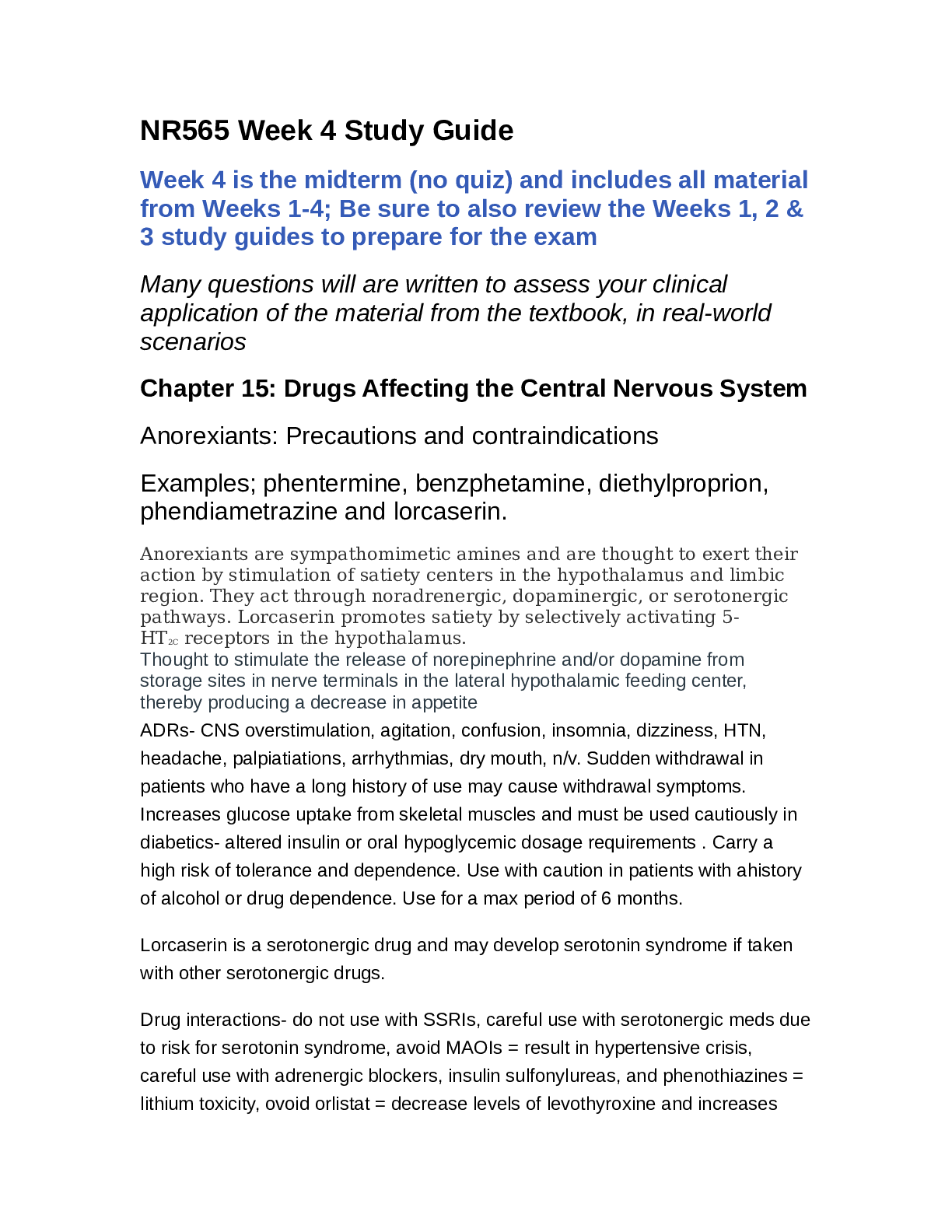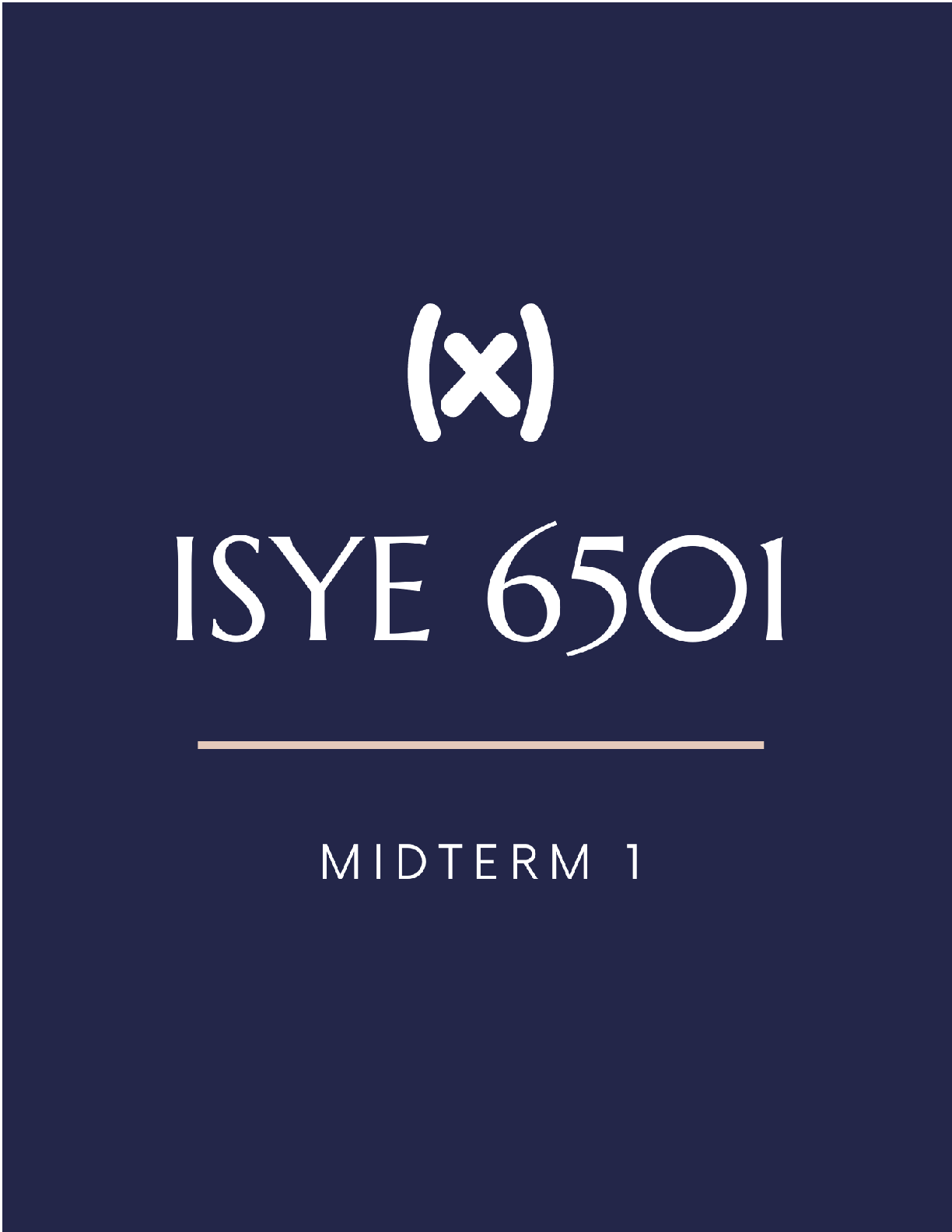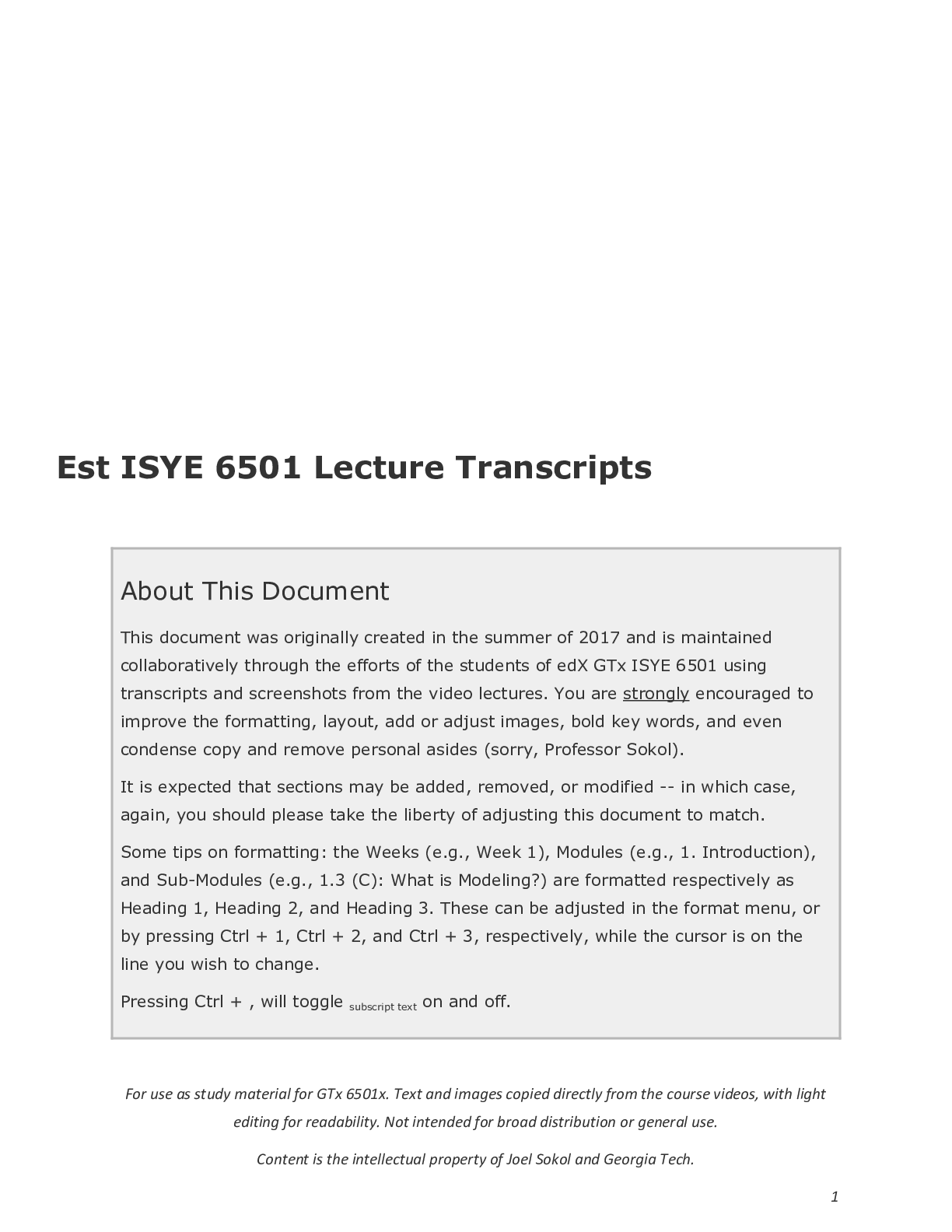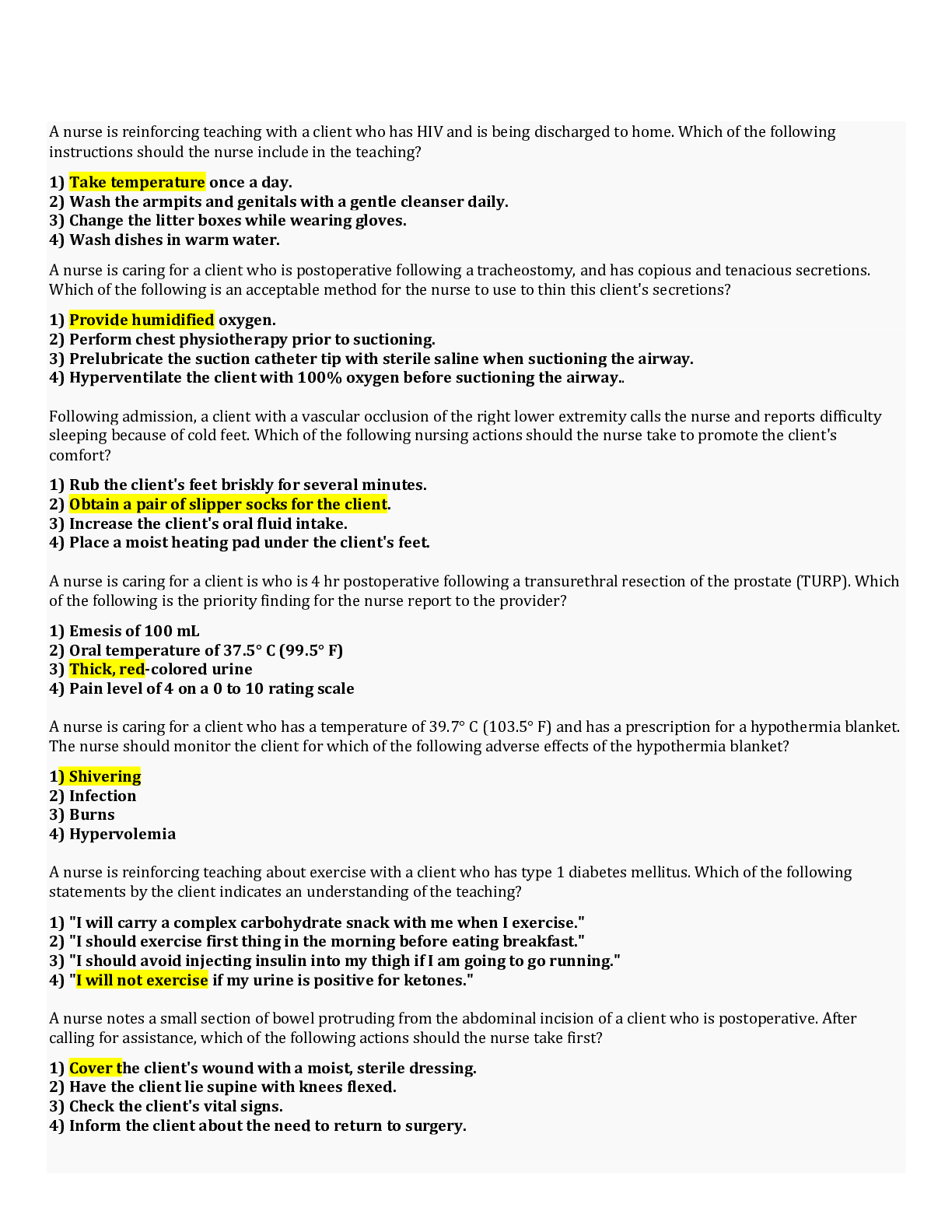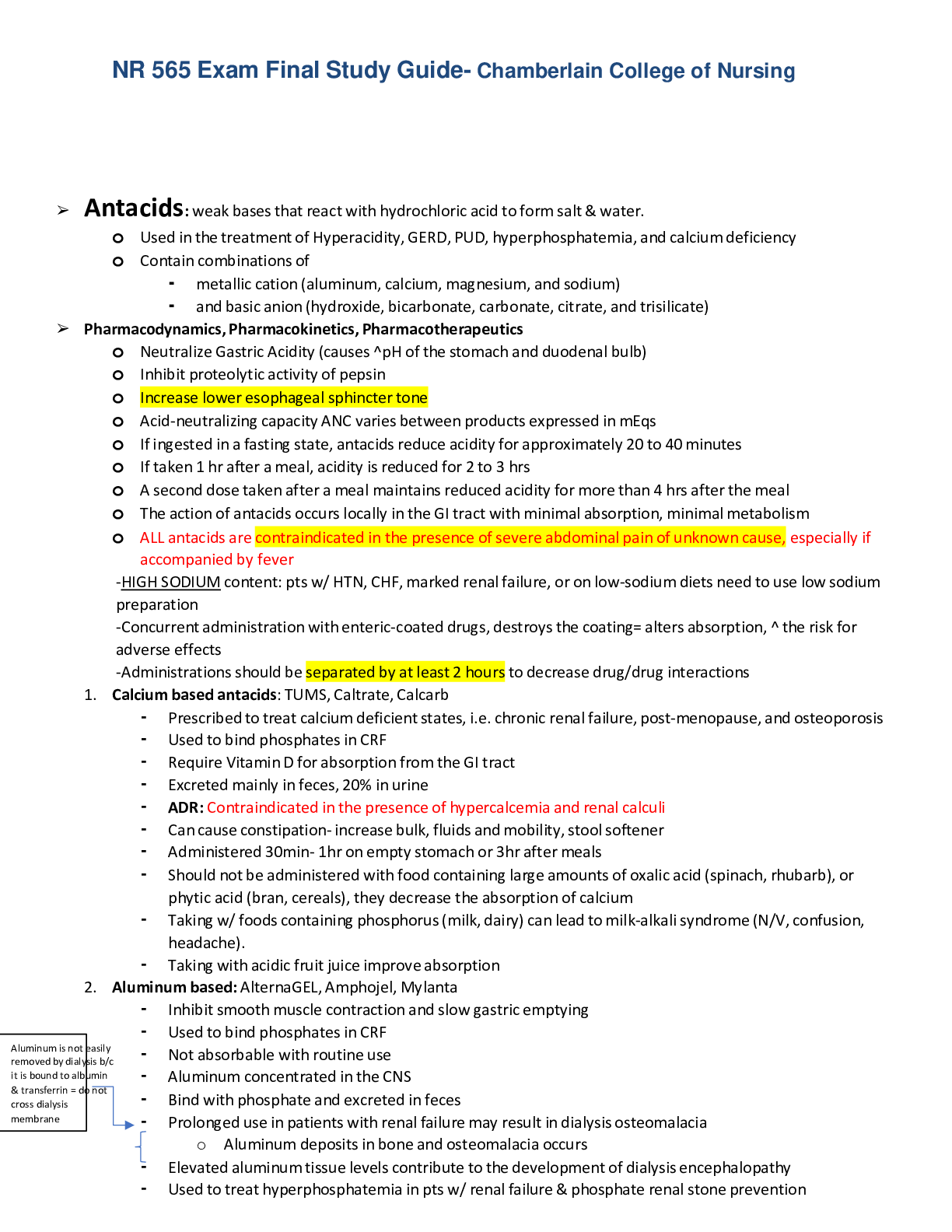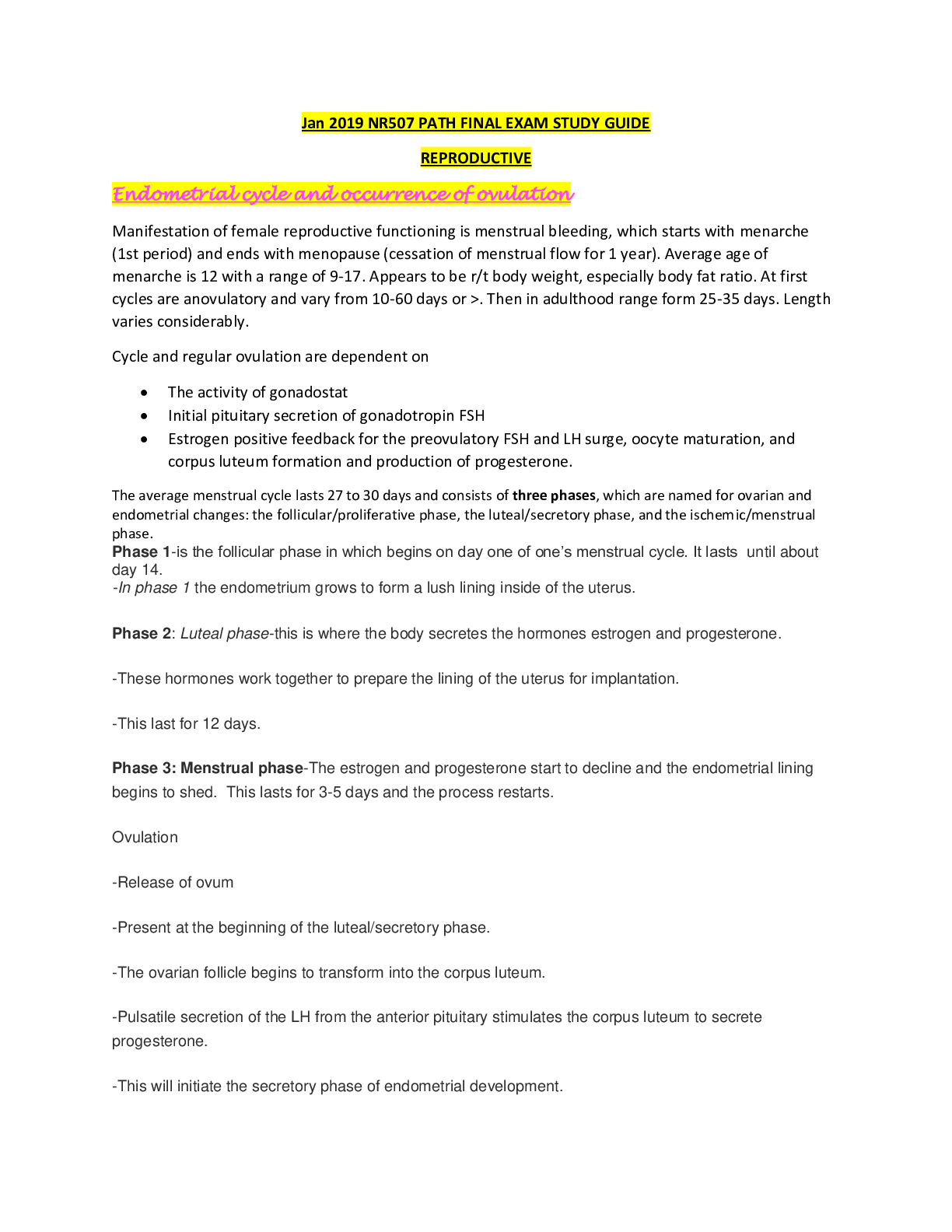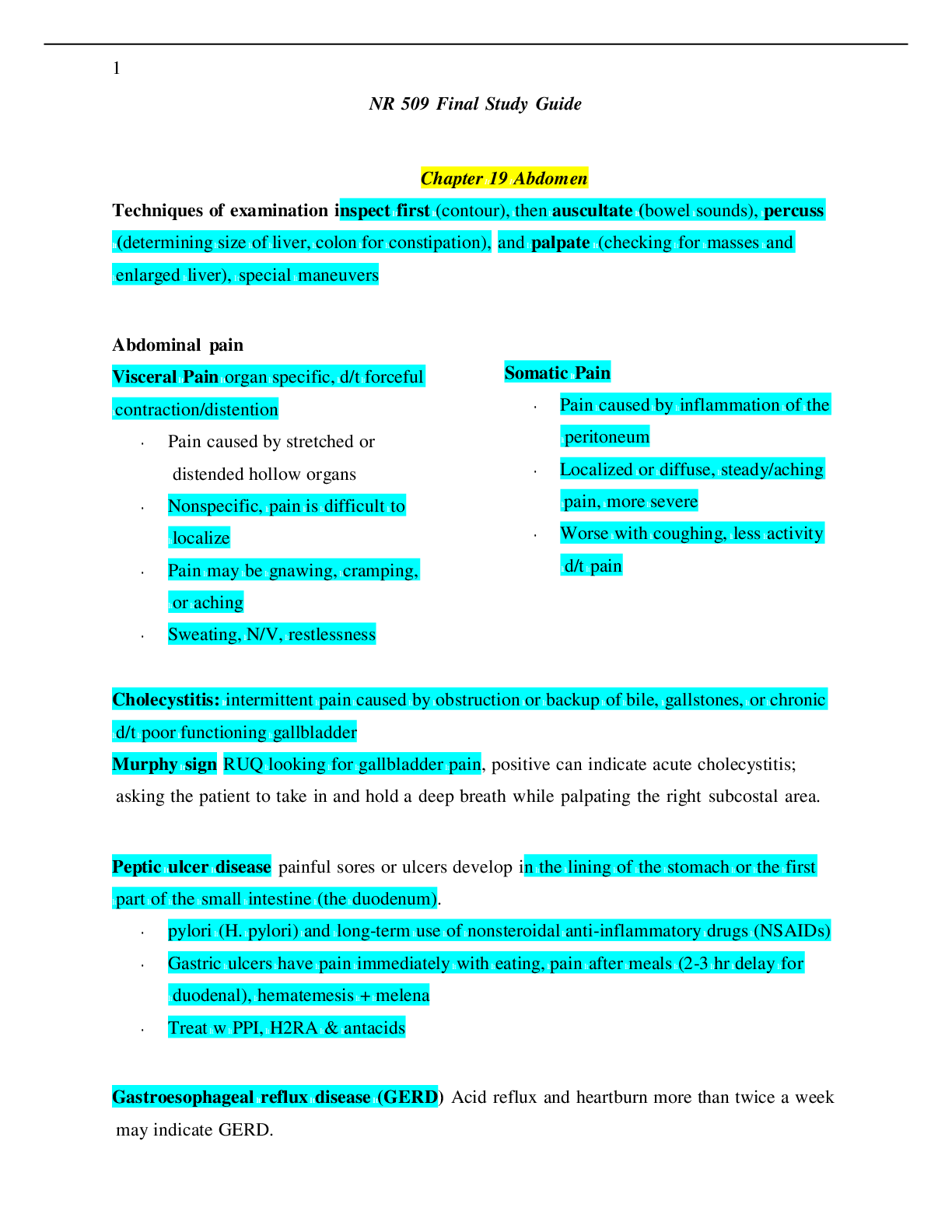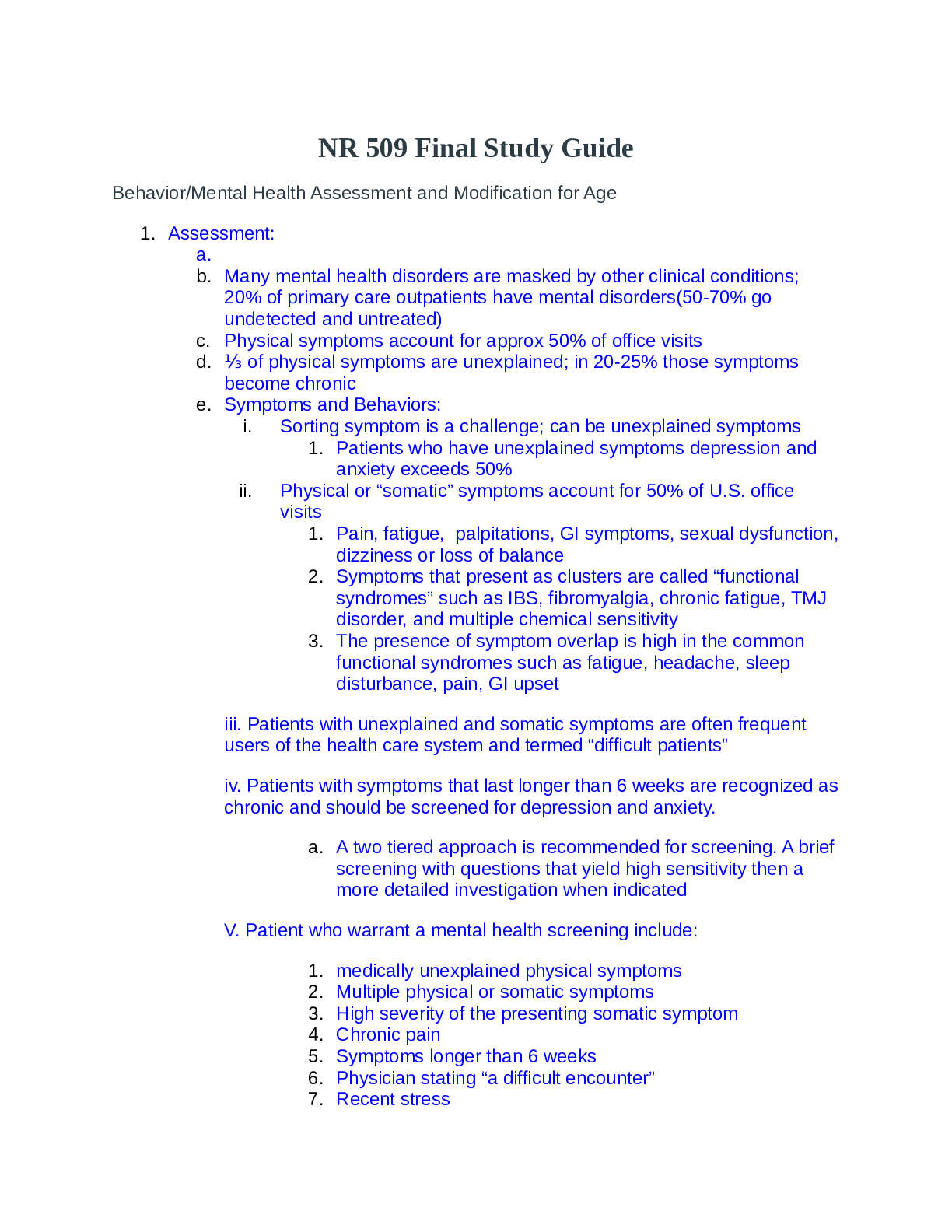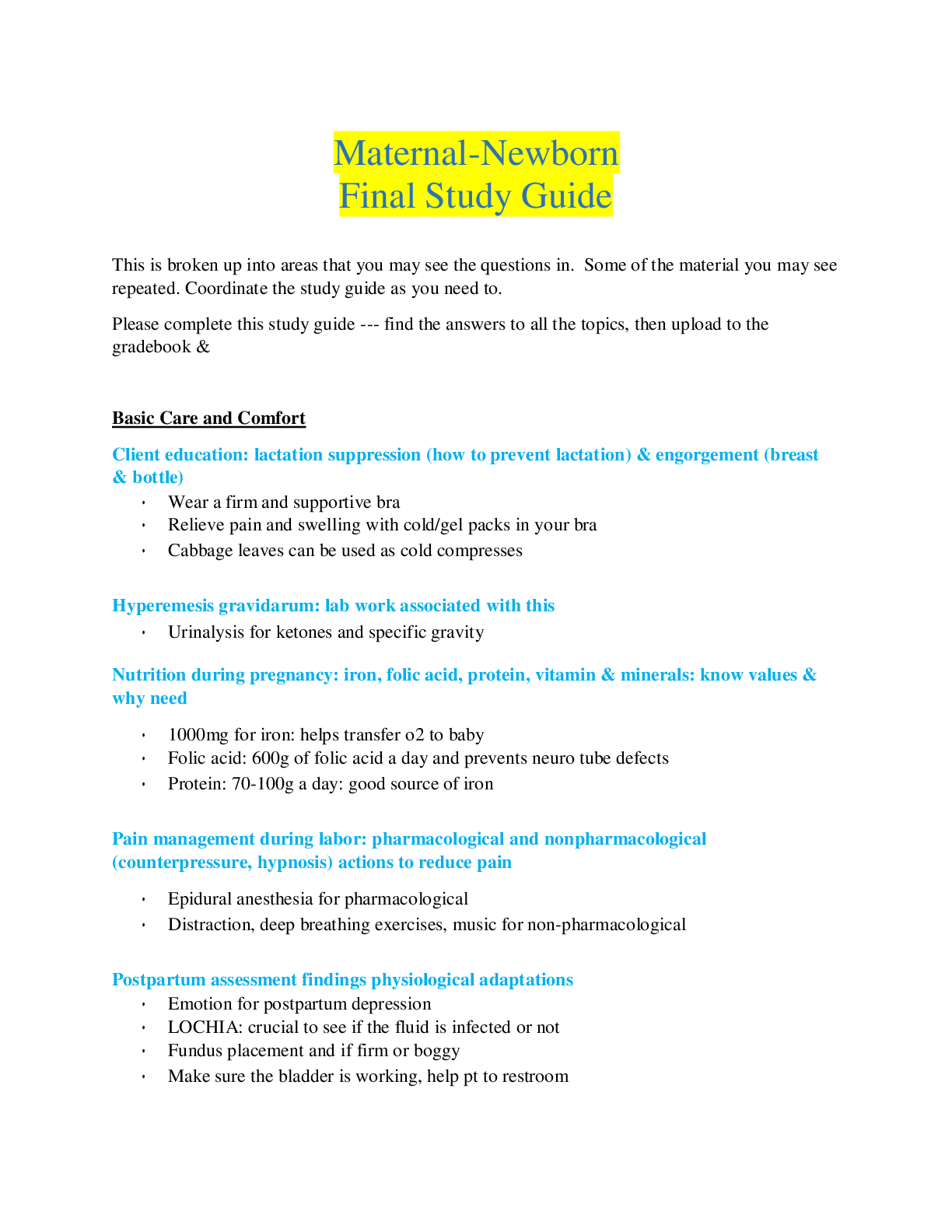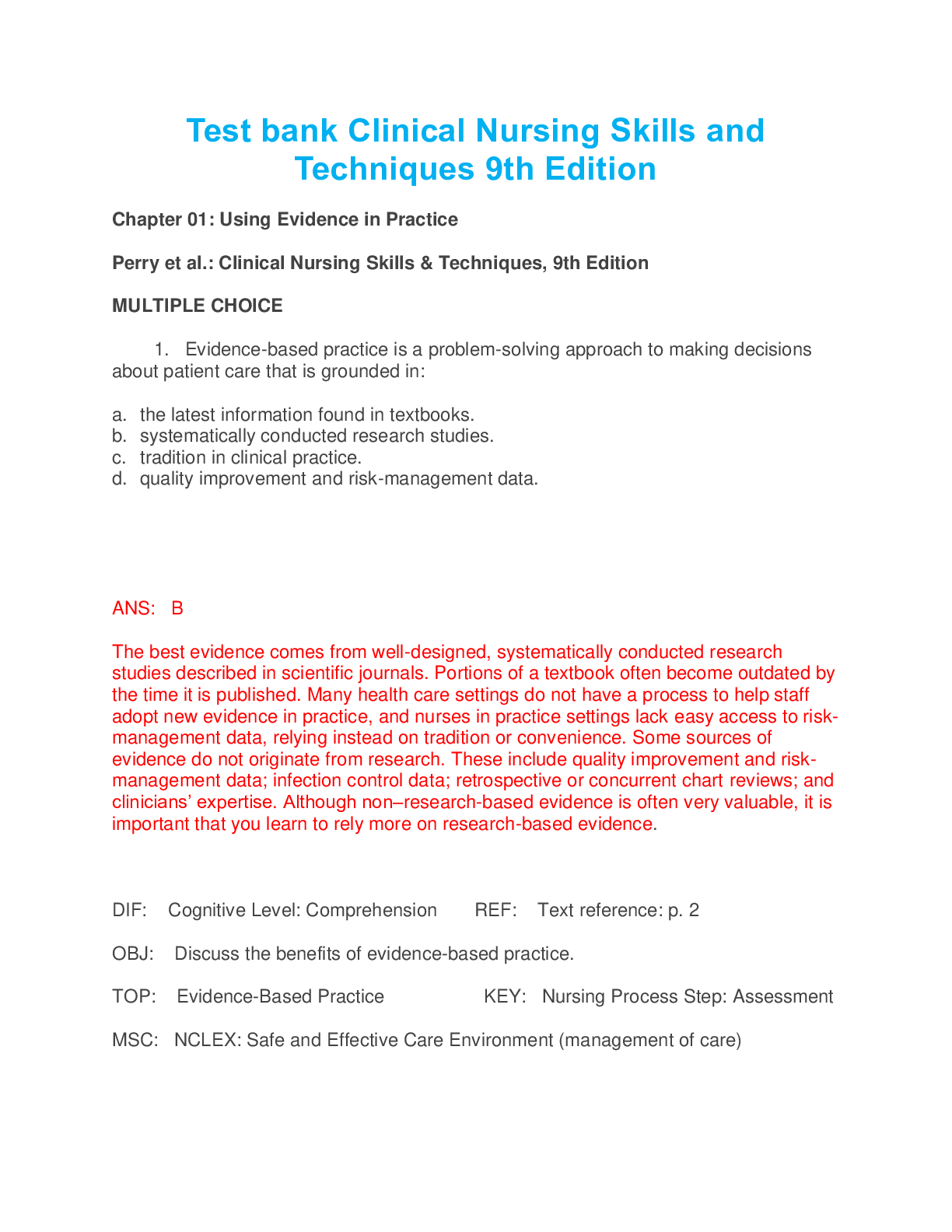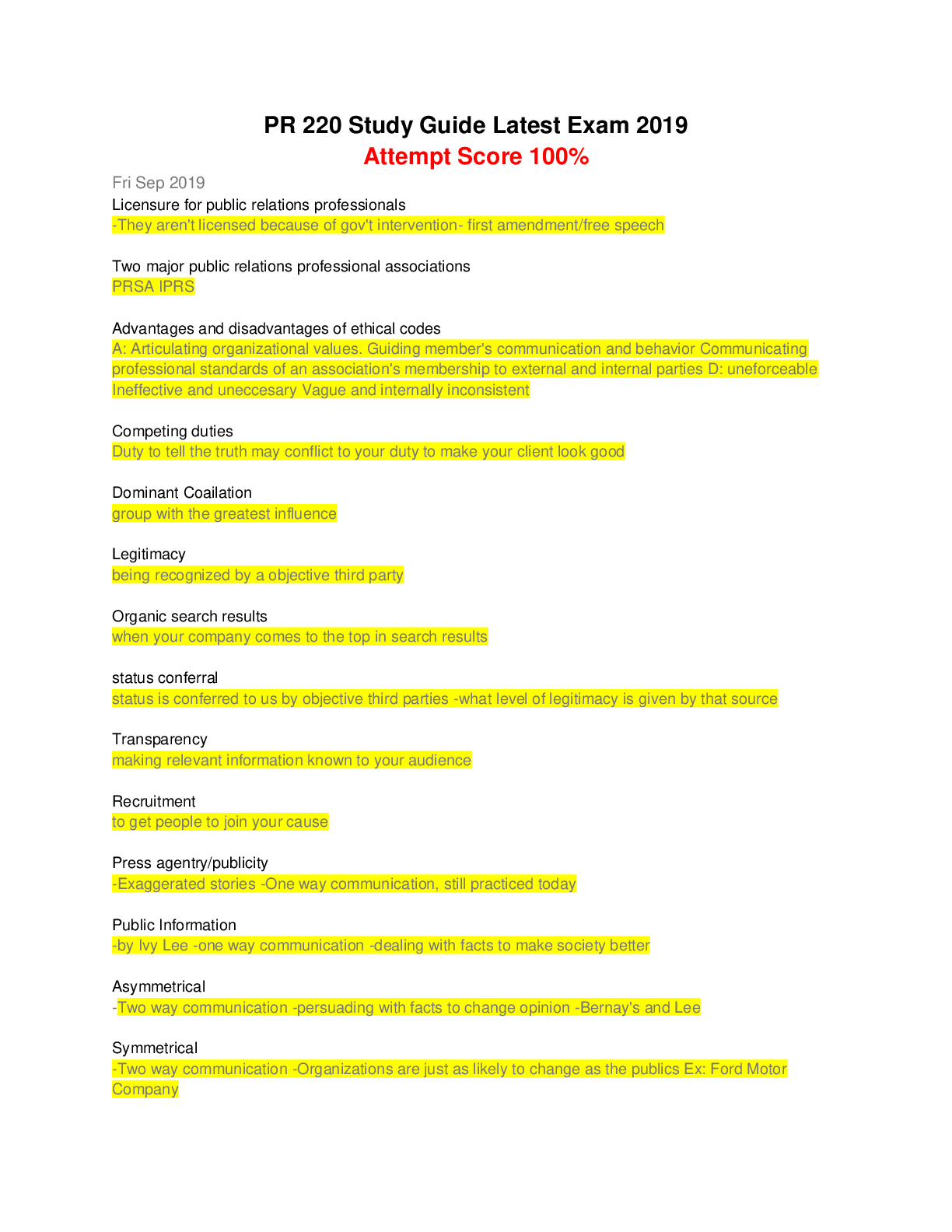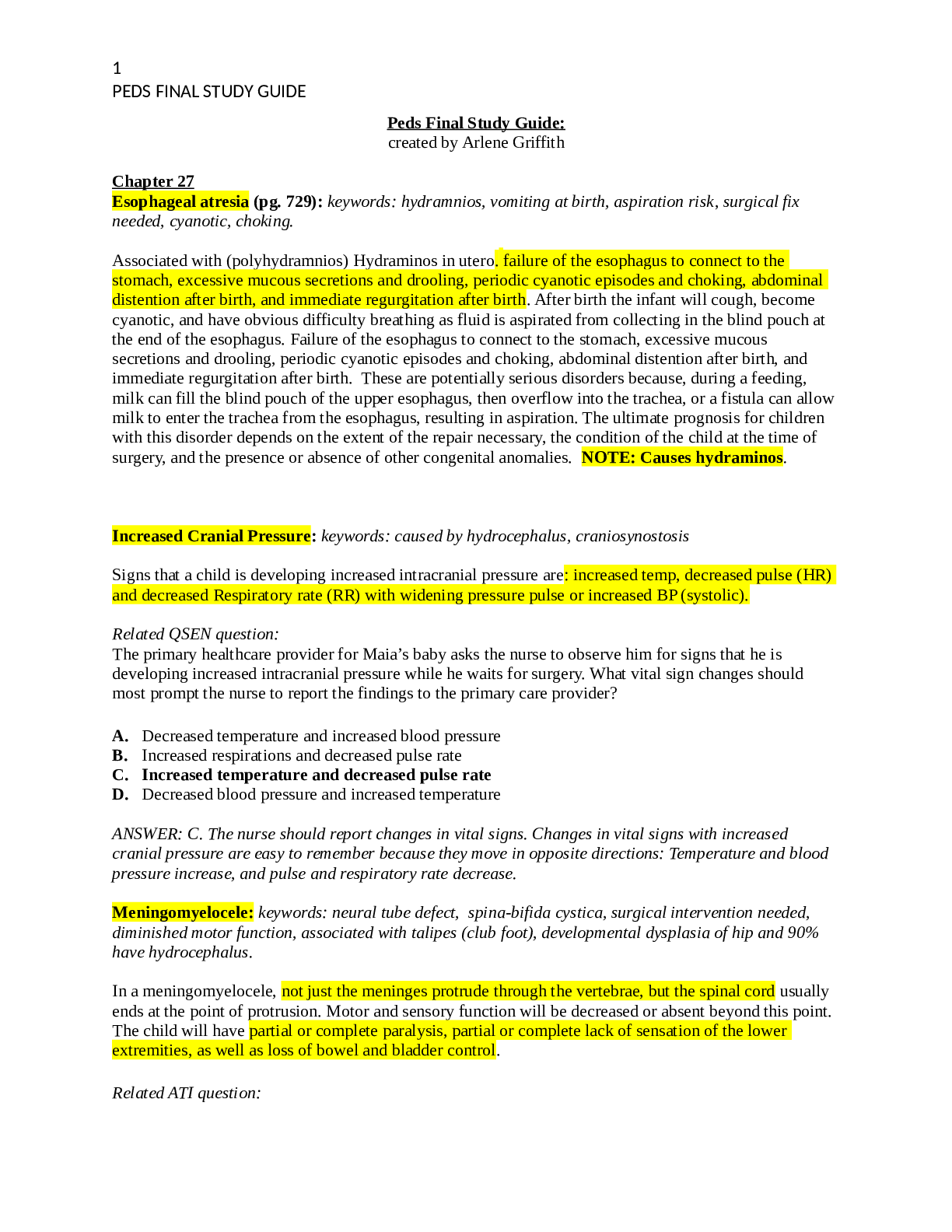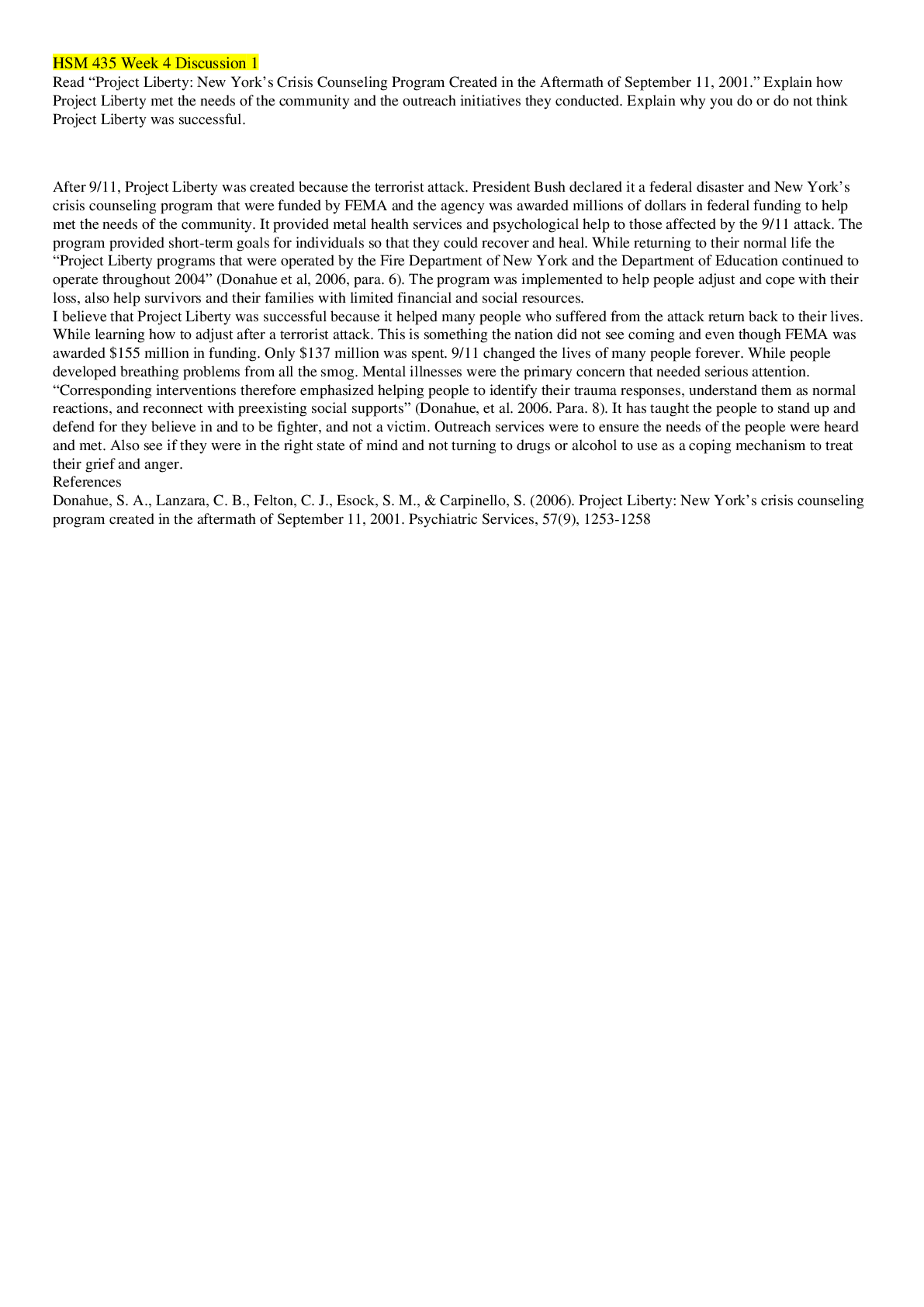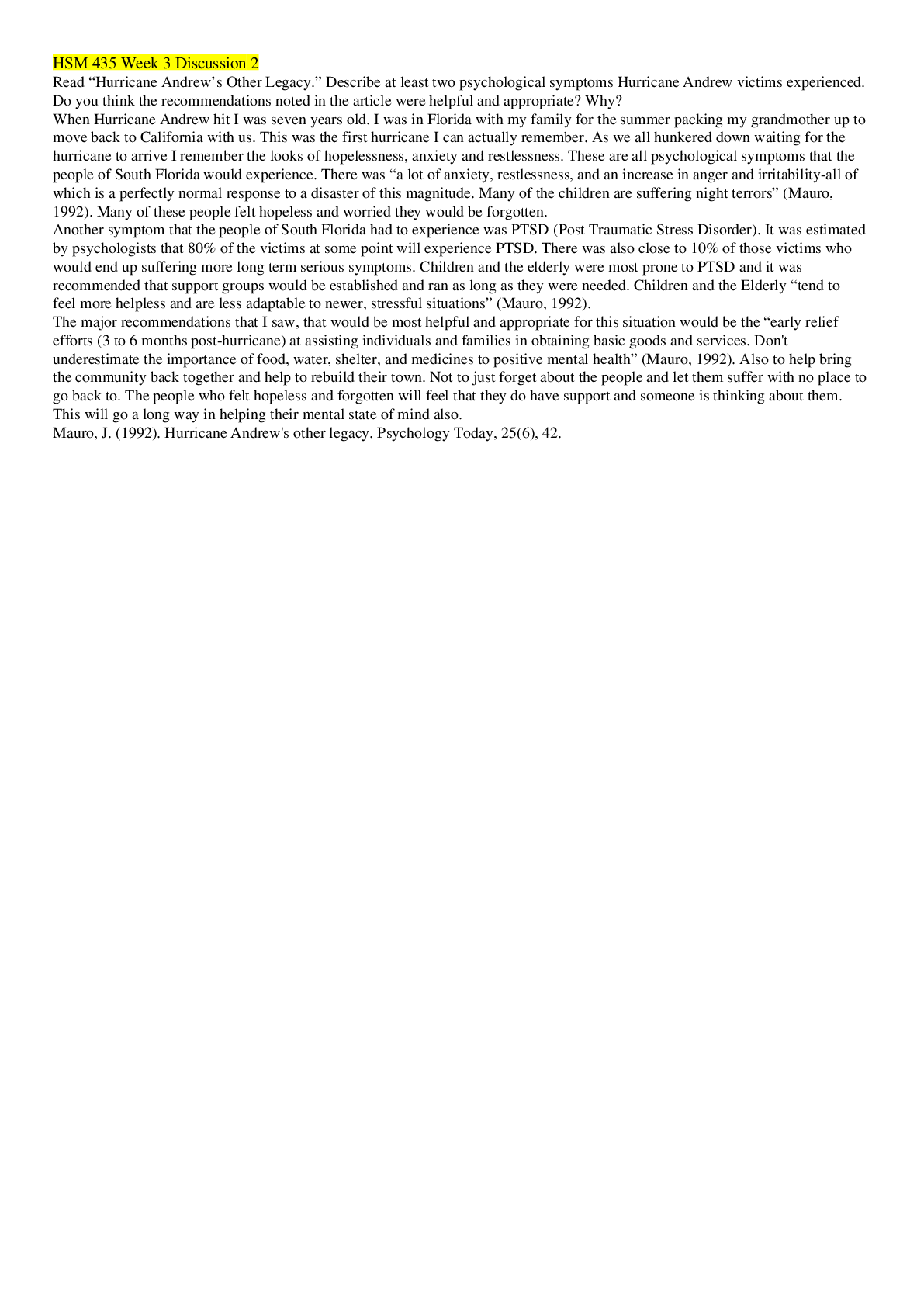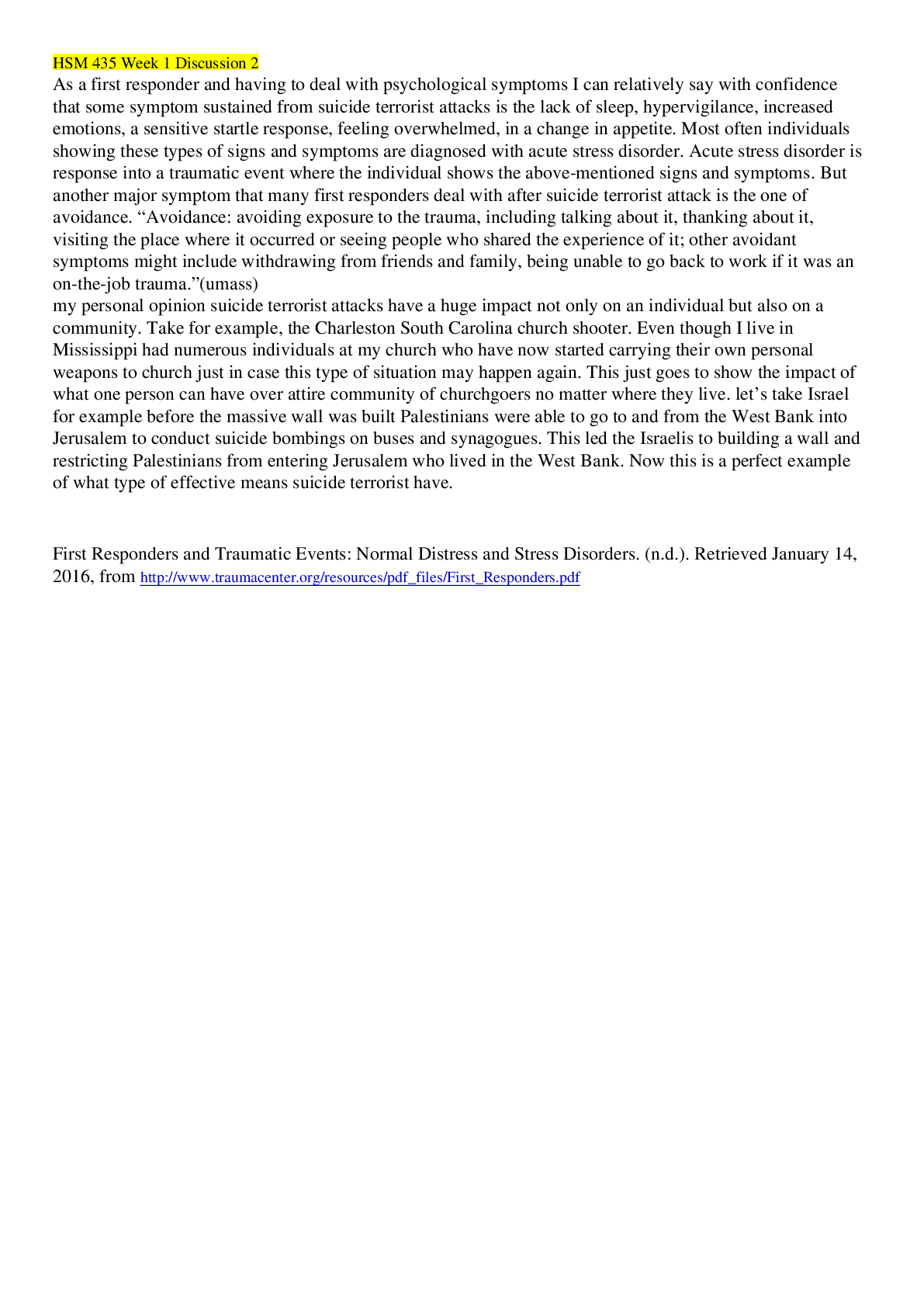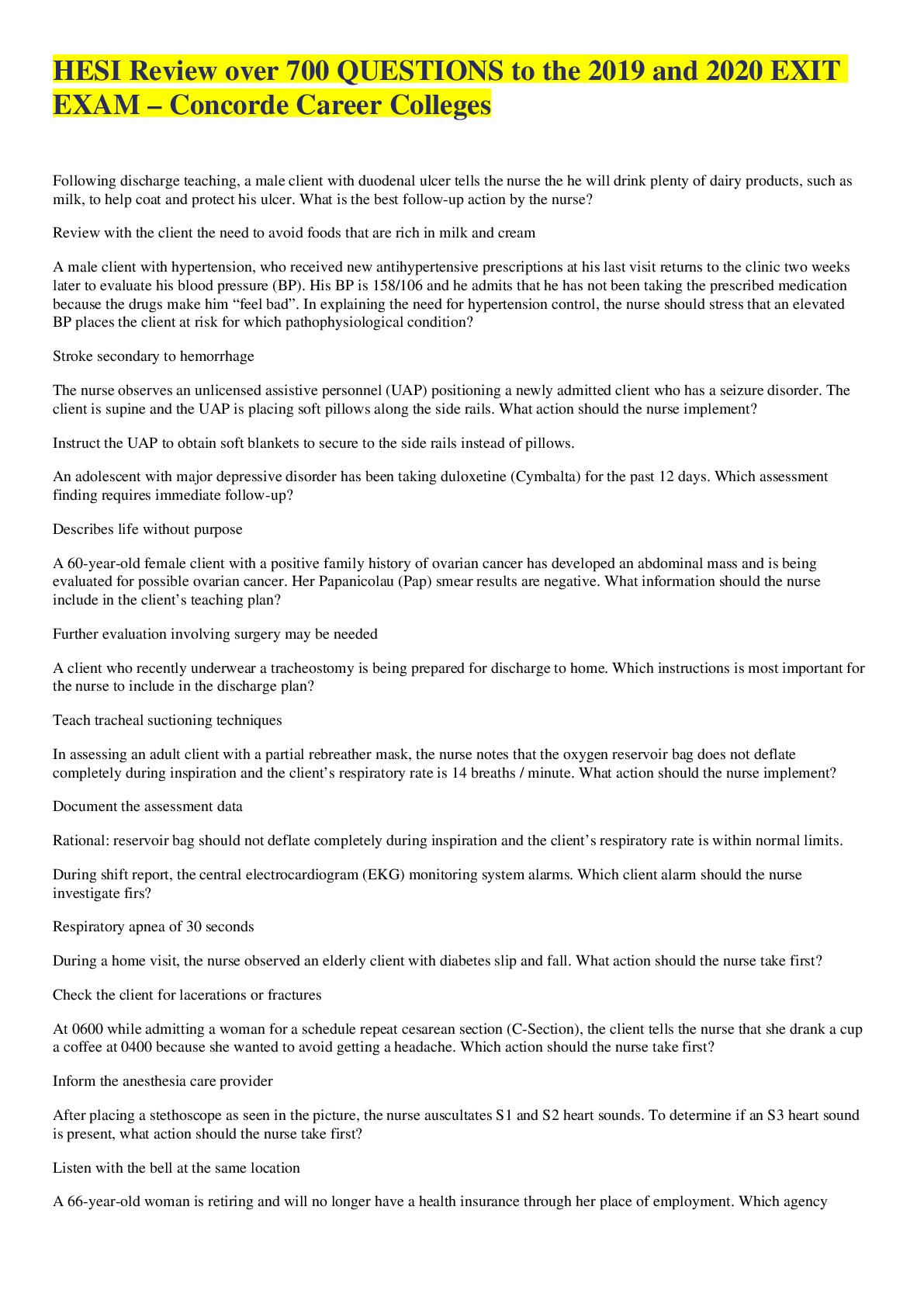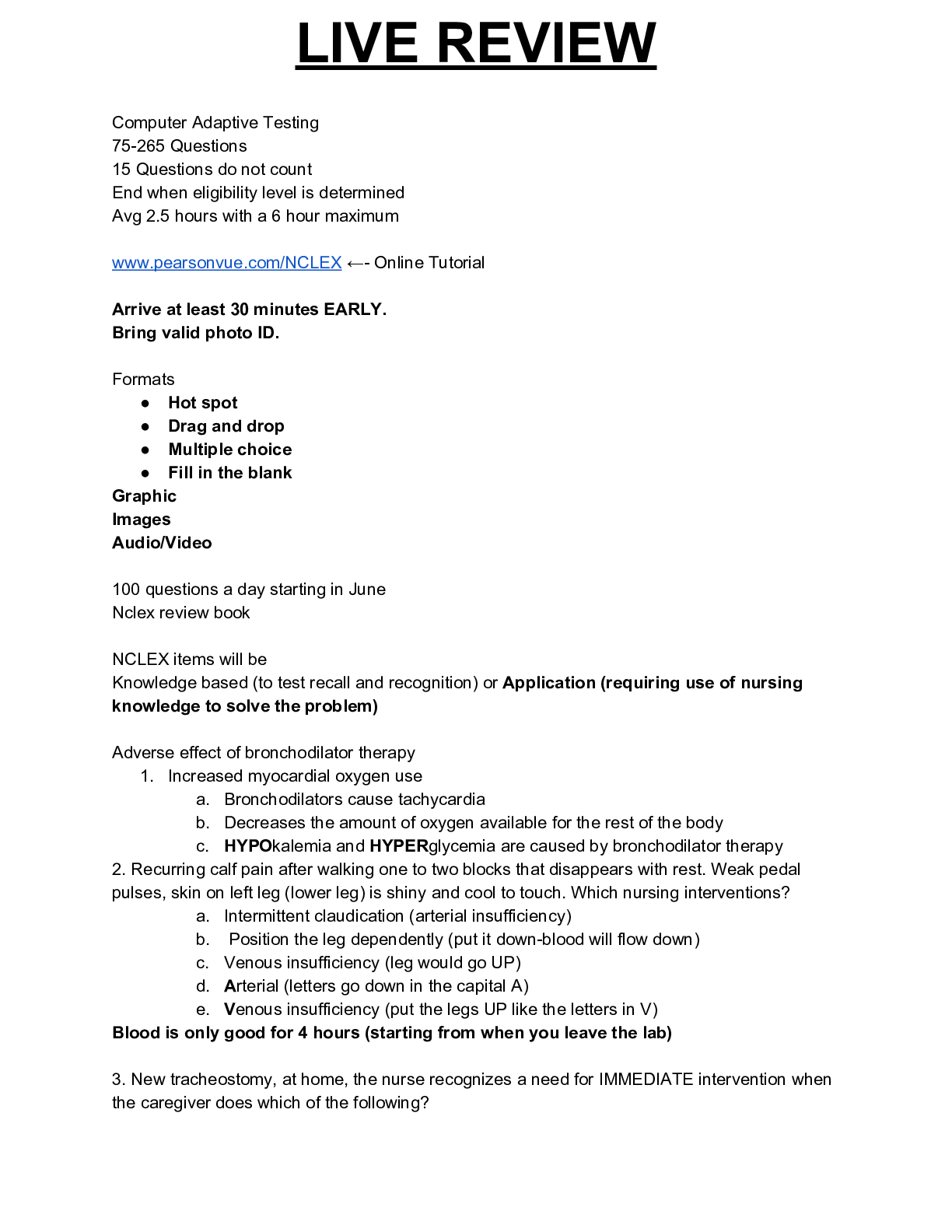Anatomy > STUDY GUIDE > Chamberlain College of Nursing BIOS251 Final Study Guide Already Graded A (All)
Chamberlain College of Nursing BIOS251 Final Study Guide Already Graded A
Document Content and Description Below
BIOS 251-Final Study Guide 1. Describe the structural and functional classifications of joints Structurally joints are classified as Fibrous, Cartilaginous and Synovial Fibrous: No synovial cavity ... Ex: Sutures - dense fibrous CT Syndesmoses: More dense fibrous CT than a suture Ex: Gomphosis Interosseous Membranes: a broad sheet of dense fibrous CT Ex: Between radius and ulna Cartilaginous: No synovial cavity (Syn=No Chondrosis=Cartilage) hyaline cartilage; no movement Ex: Epiphyseal plate - growth plate Symphysis: fibrocartilage; some small movement Ex: Pubic Symphysis - held together by cartilage Epiphyseal plate, Vertebral discs Synovial: Have a synovial cavity Articular cartilage on ends of long bones and a synovial cavity between articulating bones surrounded by accessory ligaments; freely moveable. Ex: Hip, Knee, Shoulder, Elbow -have articular capsule & have accessory ligaments that help support Functionally joints are classified as Synarthroses, Amphiarthroses, Diarthroses Synarthroses: Allow no movement Ex: Suture, Gomphosis (Joint classification: Fibrous) Amphiarthroses: Allow little to no movement Ex: Pubic symphysis, intervertebral discs - small amounts of movement - few degrees (Joint classification: Cartilaginous) Diarthroses: Freely moveable Ex: Hip, Knee, Shoulder, Elbow (Joint classification: Synovial) 2. Describe the types of movements that can occur at synovial joints (Diarthroses: Freely moveable - large range of movement) Gliding: Movement of relatively flat bone surfaces back and forth and side to side over one another; little change in angle between bones. Angular: Increase or decrease in angle between bones. Flexion: Decrease in angle between articulating bones, usually in sagittal plane. Lateral Flexion: Movement of trunk in frontal plane. Extension: Increase in angle between articulating bones, usually in sagittal plane. This study source was downloaded by 100000831988016 from CourseHero.com on 04-16-2022 07:57:14 GMT -05:00 https://www.coursehero.com/file/26271294/BIOS251-Final-Study-Guide/ Hyperextension: Extension beyond anatomical position Abduction: Movement of bone away from midline, usually frontal plane. Adduction: Movement of bone toward midline, usually in frontal plane. Circumduction: Flexion, abduction, extension, adduction and rotation in succession (or in the opposite order); distal end of body part moves in circle. Rotation: Movement of bones around longitudinal axis; in limbs, may be medial (toward midline) or lateral (away from midline). Special: Occurs at specific joints. Elevation: Superior movement of body Depression: Inferior movement of body Protraction: Anterior movement of body part in transverse plane Retraction: Posterior movement of body in transverse plane Inversion: Medial movement of sole Eversion: Lateral movement of sole Dorsiflexion: Bending foot in direction of dorsum (superior surface) Plantar flexion: Bending foot in direction of plantar surface (sole) Supination: Movement of forearm that turns palms anteriorly Pronation: Movement of forearm that turns palm posteriorly Opposition: Movement of thumb across palm to touch fingertips on same hand 3. Describe the disorders that affect joints (osteoarthritis, rheumatoid arthritis, etc.) Osteoarthritis: General wear and tear on joint where articular cartilage wears out Also known as degenerative joint disease Rheumatoid: Autoimmune - body attacks joints and is sensitive to dietary changes. Also known as inflammatory joint disease (#1 cause of debilitating disease) 4. Differentiate between strain and sprain A strain is a stretched or partially torn muscle or muscle and tendon. Often occurs when muscle contracts suddenly and powerfully Ex: leg muscles of sprinters when they spring from the blocks. A sprain is the wrenching or twisting of a joint that stretches or tears it ligaments but does not dislocate the bones. 5. Describe the main anatomical components of the knee joint and explain the movements that can occur at this joint 6. Identify the structural components of the glenohumeral joint Glenoid Cavity of Scapula and Head of Humerus This study source was downloaded by 100000831988016 from CourseHero.com on 04-16-2022 07:57:14 GMT -05:00 https://www.coursehero.com/file/26271294/BIOS251-Final-Study-Guide/ 7. Identify the structural components of the elbow joint Anular Ligament of the Radius Articular Capsule Radial Collateral Ligament Anular Ligament of the Radius Articular Capsule Ulnar Collateral Ligament 8. Identify the structural components of the hip joint Iliofemoral Ligament - Iliac connected to femur Pubofemoral Ligament - Pubis connects to femur 9. Identify the features found on the femur Head Greater Trochanter Lesser Trochanter Gluteal Tuberosity Medial Condyle Patellar Groove Lateral Condyle 10. Describe the disorders associated with tracking of the patella on the femur Patellar tracking disorder occurs when the kneecap (patella) shifts out of place as the leg bends or straightens. In most cases, the kneecap shifts too far toward the outside of the leg, although in a few people it shifts toward the inside. 11. Identify bones of the axial skeleton 80 Skull bones, Auditory ossicles (ear bones), hyoid bone, sternum (breastbone), and bones of the vertebral column. 12. Identify facial bones 14 Facial bones 2 Nasal 2 Lacrimal 2 Inferior Nasal Concha 2 Maxilla 2 Palatine 2 Zygomatic 1 Mandible 1 Vomer 13. Describe the location of the cranial bones Frontal, 2 Parietal, 2 Temporal, Occipital, Sphenoid, Ethmoid 14. Describe the disorders associated with the spinal column Costochondritis: Inflammation of one or more costal cartilage Lordosis: Condition characterized by an increase or exaggeration of the lumbar curve of the vertebral column This study source was downloaded by 100000831988016 from CourseHero.com on 04-16-2022 07:57:14 GMT -05:00 https://www.coursehero.com/file/26271294/BIOS251-Final-Study-Guide/ Kyphosis: Condition characterized by an increase in the thoracic curve of the vertebral column Scoliosis: Condition characterized by a lateral bending of the vertebral column in the thoracic region Herniated Disc: Condition where protrusion of the nucleus pulposus posteriorly or into one of the adjacent vertebral bodies in the vertebral column Spina bifida: Congenital defect of the vertebral column where the laminae do not develop normally (looks like open wound/pressure ulcer) 15. Describe the structural components of a long bone Greater in length than width Ex: Femur, Humerus, Phalanges, Tibia Diaphysis (bone shaft) - humerus 2 Epiphyses (both ends of the bone at the joints) 2 Metaphyses (region between diaphysis and epiphysis) Articular Cartilage covering both epiphyses Periosteum (connective tissue surrounding the diaphysis - irregular connective tissue) Medullary Cavity (hollow space within diaphysis) Endosteum (thin membrane lining the medullary cavity - can replicate to make bone thicker) 16. Describe the progression/phases of a mature bone cell Osteoprogenitor Cells: bone stem cells able to d [Show More]
Last updated: 1 year ago
Preview 1 out of 8 pages
.png)
Reviews( 0 )
Document information
Connected school, study & course
About the document
Uploaded On
Apr 16, 2022
Number of pages
8
Written in
Additional information
This document has been written for:
Uploaded
Apr 16, 2022
Downloads
0
Views
55


